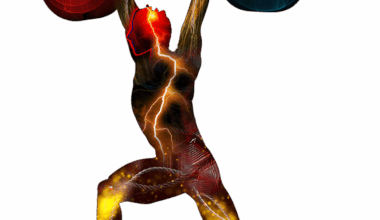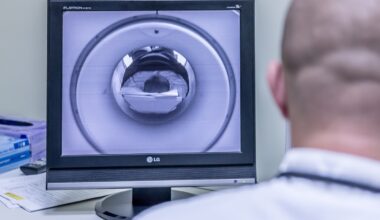How Often Should You Do HIIT for Maximum Muscle Gains?
High-Intensity Interval Training (HIIT) is an effective workout strategy designed to boost fitness and vitality. Regularly engaging in HIIT can foster better muscle gains, improve endurance, and accelerate fat loss. Balancing HIIT workouts with traditional strength training is crucial for those focused on muscle building. Training too often can lead to diminished recovery, impairing results. Therefore, optimizing frequency should be a priority. Ideally, incorporating HIIT 2-3 times each week can prevent overtraining while still delivering significant benefits. Each session should last around 20-30 minutes, allowing sufficient intensity without extending fatigue. Adding variety by alternating workout formats prevents monotony and enhances muscle activation to promote growth. For example, sprint intervals, bodyweight exercises, or circuit training can be rotated throughout the week. Furthermore, resting and recovery are key for muscle repair, allowing muscles to recover and grow stronger. Post-workout nutrition plays a vital role as well, emphasizing the importance of proteins and carbohydrates. Ultimately, adequate hydration and nutrition are necessary for optimal performance and recovery. This approach can accommodate varied individual fitness levels and goals, illustrating the versatility of HIIT.
Focusing on how often to perform HIIT effectively requires assessing various factors. Each individual’s fitness level, workout intensity, and overall goals will dictate how frequently they should integrate HIIT into their training schedule. Beginners should start cautiously, engaging in HIIT once a week to build a foundation. Once established, they can gradually increase frequency. For those aiming specifically for muscle gains, the addition of 1-2 HIIT sessions in combination with resistance training is often effective. Ensuring enough rest between intervals allows muscles to function optimally. Listen to your body’s signals. If fatigue accumulates, consider adjusting your frequency or intensity to maintain effective progress. Although HIIT can yield quick results, adaptation is key. Monitoring performance allows for informed decisions on workout adjustments. Adequate nutrition and hydration during recovery periods further enhance muscle growth adaptability. Also, varying HIIT methods can prevent plateaus in muscle development. Engaging in cycling, running, jumping rope, or swimming promotes diverse muscle engagement while enriching workouts. This adaptability not only mitigates boredom but also continually challenges muscle fibers, allowing for optimal gains.
The relationship between HIIT and muscle building encompasses several important aspects. Muscle hypertrophy thrives in environments of stress and recovery. HIIT can create metabolic stress, stimulating muscle growth through muscular fatigue. Nonetheless, pairing HIIT with traditional resistance training amplifies these effects, allowing for progressive overload while maintaining muscle mass. Additionally, research indicates that individuals employing both methodologies can achieve superior outcomes compared to those who exclusively perform one type of training. A well-rounded approach not only encourages muscle growth, but also enhances cardiovascular fitness. Furthermore, the metabolic boost following HIIT ensures that the body continues to burn calories even post-exercise, contributing to fat loss efforts. This post-exercise oxygen consumption can be beneficial for maintaining a lean physique alongside muscle mass. It is essential that the caloric intake matches your goals; for muscle building, it needs to be elevated. Incorporating sufficient carbohydrates provides energy, while protein supports muscle repair and growth. Consequently, establishing a diet aligned with your training plans proves invaluable. Prioritizing nutrients post-HIIT sessions fosters optimal recovery and prepares muscles for upcoming workouts.
Combining HIIT with muscle-building workouts can lead to an effective training routine addressing different fitness aspects. While maximizing muscle gains, maintaining a balance between intensity and duration becomes vital. For those insisting on continuing both HIIT and weightlifting, arranged scheduling during the week can yield benefits. For instance, alternating days between heavy weight training and HIIT ensures that muscle fatigue is managed effectively. Weight sessions may target compound exercises focusing on key muscle groups, while HIIT sessions could aggregate more conditioning elements. This strategy allows muscles to recover adequately post-HIIT session while going through resistance workouts. Furthermore, muscle gain optimization may rely on varying rest periods between sets and workouts. Keeping rest periods concise during HIIT promotes metabolic stress necessary for growth. Conversely, allowing extended recovery time during weightlifting helps replenish energy stores. A strategic mix of high-intensity workouts encompassing various muscle-engaging movements reduces monotony. Emphasizing on movements that target multiple muscle groups ensures comprehensive efficiency. Whether fitness goals reflect weight loss, muscle gain, or improved endurance, adapting HIIT can lead to positive results.
Another critical factor influencing the effectiveness of HIIT is individual recovery times. Each person reacts differently based on fitness levels, age, dietary factors, and sleep quality. Recognizing these individual factors helps to tailor a HIIT routine that serves your specific needs. As you consider HIIT for muscle gains, allow adequate recovery time. Overtraining can lead to fatigue and increased injury risk, ultimately hindering long-term progress. Balance is crucial. Establish a routine that incorporates at least one full rest day weekly to promote recovery. Sleep is equally as crucial, ensuring ample hours for muscle repair and rejuvenation. Additionally, incorporating low-intensity activities such as yoga or stretching can aid recovery, enhancing flexibility and mobility. Monitoring your body’s response can help in determining necessary changes to your training schedule. Maintaining an active diary of training sessions, intensity levels, and recovery experiences will provide insights. This proactive approach helps in managing efforts effectively. Emphasis should be placed on specific muscle groups and which require prioritization based on the week’s activity, allowing preventable adjustments to be made.
The Role of Nutrition in HIIT and Muscle Gains
Nutrition serves an essential role in supporting the relationship between HIIT and muscle building. Adequate energy intake is fundamental since you are expending energy during HIIT sessions. Carbohydrates act as the main fuel source, providing the necessary energy to perform effectively. Not only does nutrient timing matter, but also focusing on the quality of food bolsters muscle gains. Consuming a meal rich in protein and carbs post-HIIT enhances recovery. Protein intake is particularly critical as it supplies amino acids needed for muscle repair and growth. Recommendations suggest at least 1.6-2.2 grams of protein per kilogram of body weight daily for muscle builders. Additionally, incorporating healthy fats contributes to overall well-being. Micronutrients from fruits and vegetables are just as relevant, playing pivotal roles in metabolic processes and recovery. Hydration, particularly before and after workouts, is crucial in achieving optimal performance. Lastly, adjusting your caloric intake depending on your training phase, be it gaining muscle or losing fat, ultimately optimizes outcomes. Paying attention to diet complements the physical effort and commitments applied each week, enhancing the efficiency of your HIIT routine.
In conclusion, incorporating HIIT into a muscle-building routine offers multiple benefits when approached with balance and intention. The frequency of HIIT should align with personal fitness goals and existing training regimens. By recognizing your body’s distinct requirements, modalities, and preferences, you can tailor HIIT sessions accordingly. Effective integration coupled with strength training enhances muscle development while improving cardiovascular health. The influence of nutrition cannot be overstated, ensuring that adequate recovery fuels subsequent workouts. Maintaining hydration, enriching meals, and optimizing recovery contribute significantly to the success of any training program. By visualizing your objectives—be it muscle gain, endurance improvement, or fat loss—you can adjust your HIIT routines. Furthermore, introducing variation can preserve motivation while enhancing overall effectiveness. This adaptability ensures that both progressive overload and metabolic conditioning coexist harmoniously, creating a pathway to fitness success. Ultimately, understanding how HIIT works in relation to muscle gains provides a holistic view on achieving desired results. Engaging with HIIT regularly is both enjoyable and rewarding, keeping you committed to your goals through persistence and resilience.
To truly reap the benefits of HIIT, it becomes vital to focus on creating structured plans and incorporating suitable adjustments based on personal progress over time. Regular evaluations of the training schedule not only bring improvements but also spark motivation. Making informed decisions regarding workout intensity or frequency ensures the journey toward muscle gains remains rewarding and fulfilling. Conclusively, sticking to the original plan while tweaking elements along the way reflects policing one’s fitness process. Establishing intuitive training cycles based on current actions while continuously reinforcing a strong foundation provides the path for achieving outstanding results.


